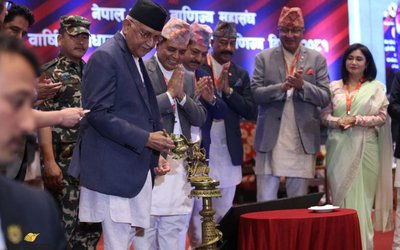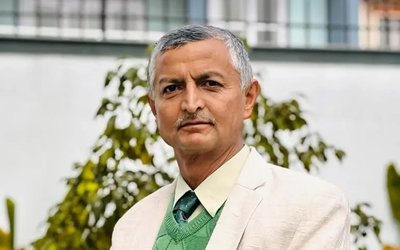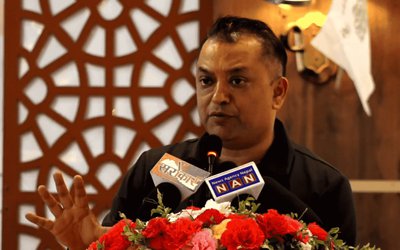
Having spent a long career in the civil service, Bishwa Prakash Pandit has taken up the job of secretary at the Water and Energy Commission Secretariat. He feels despite Nepal being rich in water, the utilization of the precious resource remains far from being satisfactory. As the nation is celebrating the World Water Day 2013, secretary Pandit spoke to New Spotlight on these issues. Excerpts:
Annually, Nepal celebrates the World Water Day. As a secretary of the Water and Energy Commission Secretariat, a highest think tank dealing with water resources, how do you see the state of water in Nepal?
Nature has endowed Nepal with precious water resources in the form of snow, rivers, wetlands, groundwater etc. These water resources are not infinite. They are limited. A study has revealed that, the per capita water availability in Nepal was 8,500 cubic meters in 2010, and it is going to decrease to 5,500 cubic meters by 2030. Further decrease will be due to the increase in population in the years to come. In addition, the water quality is also continuously deteriorating due to urbanization and industrialization. Water is one of the potential resources for enhancing the prosperity of the Nepalese people. Hence, there is a need to harness this precious resource wisely and sustainably for availing maximum benefit.
What is the role of the WECS in the context of providing necessary support to the government on water related issues?
The Water and Energy Commission was established in 1975 and its Secretariat (WECS) was set up in 1981 with the objective of developing water and energy sector as a whole in the country. The role of the WECS is to conduct study and research on various aspects of water and energy as to support formulation of policies and strategies in these sectors. It also provides opinion, advice and recommendation on the issues for developing water and energy sector to the government.
In the changing context following the split of the Ministry of Water resources into two, what difference will this make to the WECS?
In Nepal, hydropower is the major potential energy source; therefore, water and energy sectors cannot be looked at in isolation. The split of Ministry of Water resources into two i.e., Ministry of Irrigation and Ministry of Energy, has created a gap in planning and development of water resources by adopting an integrated approach. This has created additional challenges to the WECS in regards to establishing effective coordination for holistic development of water resources.
As the WECS prepared the Water Resources Strategy a long time back, don’t you think the time has come to revisit the strategy looking at the present situation?
Some of the activities identified by the Water Resources Strategy (2002) are being implemented and some are yet to be implemented. Two schools of thoughts have emerged during discussions with different stakeholders. Some argue for the need to let all the activities be implemented and then start revisiting the strategy. Others emphasize on initiating work to revisit the strategy right away. In my opinion, it would be appropriate to do the review in 2017 as it is the mid-term period of the strategy.
Is the WECS doing work on this?
The WECS is continuously acquiring data and information on the status of implementation of the activities identified in the strategy. The review process will be initiated in 2016.
At a time when Nepal's more than 30 percent of population has yet to gain access to safe drinking water and Nepal is still far from meeting the Millennium Development Goals on water, what measures do you suggest to make water available to all?
Nepal has been successful in achieving some of the Millennium Development Goals in the health sector. However, in case of water and sanitation sector, we are lagging behind. An integrated planning of water resources, based on river basin approach, implementing the projects of various scales depending on the water requirement for the citizens and designing the scientific cost recovery mechanism for sustainability of the systems are the keys to provide safe and clean water to all.
As Nepal has already been declared a federal state, how complex will it be to work in the context of water sharing? What has the WECS been doing in this regard?
Technically, sustainable development and management of water resources will be effective if we followed the river basin approach. The boundaries of federal states are not yet clear and therefore the complexities cannot be explained concretely at this stage. The critical issues hover around the ownership of the resources, whether it lies with the center or with the states. There is a need to harmonize the administrative boundaries and hydrological boundaries for addressing the water sharing issues. Realizing the complexities, the WECS has initiated work to assess and analyse the water availability for existing and future water resource projects with due consideration to maintaining the downstream flows in the river basin perspective.
Nepal is regarded as most vulnerable to water related disasters and climate change is going to be a big threat to the country. How is the WECS looking at this?
Water related disasters and the climate change effects are emerging as a major threat to the globe. Nepal is also the victim of the same. Regarding water induced disasters, structural and non-structural mitigation measures are required to be implemented. In case of climate change threat, the only option is to study, design and implement the adaptation mechanism. Recognizing the threats, the WECS has initiated work to incorporate water related disasters and the climate change issues while preparing the integrated river basin plan.
How do you explain the relevance of the WECS in the present context?
The government agencies, working in water resources sector, are mandated on the basis of the sub-sectors, i.e., irrigation, hydropower, water supply, etc. The policies, plans, programs and activities designed by these agencies are primarily focused on the sub-sectors ignoring water resources as a whole. This process does not recognize the integrated planning concept as such, as conflict among the different water uses may emerge. In this front, the role of the WECS will be more prominent and of relevance for coordination at policies, plans, programs and activities level. Further, the role of the WECS is instrumental in minimizing the conflict among water uses by assessing the water quantity and formulating the integrated water resource plan.
How much do other ministries support the WECS in the areas of research on water related issues?
The secretaries of different water related ministries are the members of the Water and Energy Commission (WEC). The policies, strategies, plans and programs designed following an integrated approach need to be endorsed by the WEC. Thus, these are owned by the ministries concerned and become the guiding documents for sub-sectoral planning. Recognizing the importance of the activities, concerned ministries are always willing to support the WECS in coordination as well as to provide data and information.
You have been there for almost over a year as a secretary, what is your impression about the WECS?
The WECS is an important research oriented government agency actively working in water and energy sector. The role of the WECS cannot be ignored. The outputs generated add values in sustainable development of water and energy resources of the country. I, as a career administrator, have got the opportunity to acquire technical knowledge and expertise in water and energy sector by working in this esteemed agency. My personal belief is that, every bureaucrat working in water and energy sector need to spend some of their tenure in the WECS for refreshing the knowledge and skills.
Along with doing research and recommending the policy issues, what other role does the WECS have?
The WECS is currently implementing water and energy related projects with support from various bilateral and multilateral donor agencies. Nepal Energy Efficiency Program (NEEP) supported by the German Government, Bagmati River Basin Improvement Project supported by the Asian Development Bank, and Irrigation and Water Resources Management Project supported by the World Bank are some of the examples. The WECS has initiated work to promote and advance river basin planning concepts to optimize water use benefits and minimize conflicts. As an initial step of the process, basin/sub-basin committees of the water users has been formed. This basin committee works closely with District Water Resources Committee to plan and monitor the water resource activities.
- IME GROUP: Expands Into Paper Industry
- Mar 24, 2025
- CPN UML: Instigated By India
- Mar 23, 2025
- ADB’S CHIEF ECONOMIST: Nepal Reduces Poverty
- Mar 11, 2025
- FM DR. DEUBA: A Successful Visit
- Mar 11, 2025
- MD GHISING: Target Of Personal Grudge
- Mar 09, 2025















